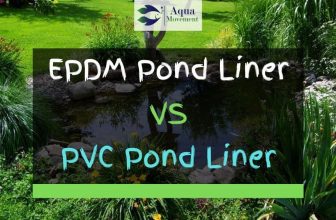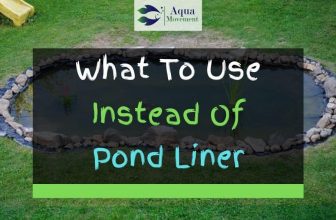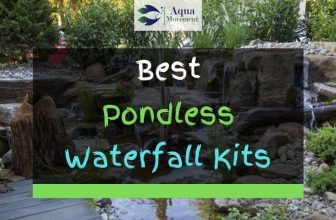How to Get Rid of Algae in Ponds
Everyone with a pond in their garden, either for ornamental purposes or for keeping fish, wants to make sure it is as healthy and pristine as possible.
Algae is the enemy of a healthy pond. It is unsightly and can greatly damage the ecosystem. This means that your beloved fish could struggle to thrive in an algae chocked pond.
Luckily, once the problem is identified, there are a host of possible solutions. These solutions range from simple natural remedies, to more involved chemical or mechanical treatments.
If algae is the bane of your life, then you’ve come to the right place. We will walk you through the process of how to get rid of algae in a pond!
Table of Contents
What is Algae?
First things first; before you can eradicate this monster you must learn to identify it.
Algae is a primitive life-form that thrives in aquatic environments. It consists of very simple organisms, which combine water and carbon dioxide to make sugars which it uses for energy and further growth.
It can quickly overtake any pond once it gets a toehold. This is because the simple cells reproduce very quickly. It has a slimy green appearance, that is the thing of most pond keeper’s nightmares.
Not all algae is created equal. There are two main forms of algae which you should be aware of.
Green Water algae are single celled organisms, that are truly microscopic. They can easily pass through pond filters. They do not attach themselves to banks/rocks, instead remaining suspended in the water. They thrive in conditions of high sunlight and nutrients essential for growth.
The other main type is string algae. You might have also heard people call this “hair algae”. As the name suggests, this has a long, filamentous or “stringy” appearance.
They often attach themselves to rocks and other features, and can mass together to completely block the water beneath them. This can be detrimental for any living things in the water, as well as very aesthetically unappealing.
Why get rid of algae in Pond?
Now that you now the scientific basics of what algae is and how to describe it, it should be pretty obvious why it should be avoided. Algae grows so quickly that it can very quickly overwhelm your pond’s ecosystem.
For example, string algae colonies can double in size every day. This exponential growth can have a terrible effect on your fish stocks. Not only do they block out sunlight to the fish, but at night they also use up the dissolved oxygen through respiration. Fish need this dissolved oxygen to breath, so stock levels can quickly be depleted.
Also, for the proud pond keeper, algae just looks terrible and can quickly ruin many months of hard work! It reduces water clarity and can turn the best kept pond into a murky, dank swamp!
How to get rid of Algae in Pond?

The pernicious problem of algae in ponds has prompted some very novel solutions. In general, these solutions fall into three categories; natural, mechanical or chemical.
Natural solutions rely on simple living things or other means to remove the algae without introducing foreign chemical or machinery.
Mechanical solutions use machines to remove the conditions for algae, and chemical treatments use special solutions to directly attack the algal bloom.
Each of these methods has their own advantages and disadvantages, and we will discuss each in turn. So let’s dive into our guide about how to get rid of algae in ponds.
Natural Solutions To Get Rid Of Algae In Pond
Pond Plants
One of the easiest ways to get prevent algae from blooming is to plant aquatic plants in your pond. Not only is this an opportunity to beautify your pond, the plants also absorb all the nutrients and goodies that attracts algae in the first place.
Without these nutrients, the algae cannot grow so they will quickly die off. Some examples of good aquatic plants to achieve this are lily pads, cattails or watercress.
[amazon box=”B00YZ6CH0G”]
Of course, the more of these plants you use, the less chance that algae will return. For this reason, most experts advise that over half the surface of the pond should be covered with these plants.
This is a chance for you to be creative with your pond, and choose plants that will really add to the local ecosystem. These plants could even become a home for other aquatic life forms, such as frogs or newts!
Stop Overfeeding
Other action that you can take to prevent and get rid of algae is to stop over over-feeding your fish. Although it might not seem obvious, this is one of the most common causes of algae growth.
If you give the fish in your pond too much food, then the food that they don’t consume can become a real magnet for algae. Once it falls to the bottom the food starts to rot. This can release all the nutrients and this dispersion is what attracts the algae.
They will come like moths to a flame, until your pond is soon overwhelmed. Inexperienced pond owners are often unsure about how much food to feed their fish, so they cautiously give them too much.
As a general rule, you should only give them a sprinkling of fish food a day for an average sized pond. Certainly you should give them no more than they can eat in a few minutes. If in doubt you should consult the instructions on your chosen fish food.
Mechanical Solutions To Get Rid Of Algae In Pond
Of course, natural solutions are not always the best or most effective options. In our modern, technology filled age it is no surprise that there are a host of mechanical options out there to help you resolve algae problems of any scale.
Using Aeration
One way to help rid your pond of any algae is to use aeration. Aeration is a handy technique that involves installing a bubble aerator into the bottom of your pond.
[amazon box=”B000HASBFE”]
This constantly agitates or aerates the water in your pond, and this constant motion keeps dissolve oxygen at a good level and makes a healthy environment for your fish. It can also prevent the spread of harmful algae, as they do not like to settle on constantly aerated water.
This solution requires a bit of installation work, but fine bubble aerators are widely available and their success in removing algae is widely attested.
Using UV light
Another tried and trusted mechanical technique is the use of UV light. What even is UV light you might wonder.
[amazon box=”B00474FI48″]
Well UV light is like normal optical light, but it is very high energy. This particular characteristic means it is very good at sterilizing things, meaning it can kill of living microorganisms.
In fact, UV light is widely used in industry and medicine to do just that, and it is equally effective in ponds. It sterilizes the water, meaning that harmful algae colonies can be detected and killed before they even become a visible water. It can also help to break down large algae blooms that have already taken over your pond.
However, it is important to think about the placement of your UV light source, as it needs to be in a region of circulating water so that it sees all the algae. For this reason, sometimes it is not so effective against string algae.
Using A Skimmer
Of course, when you see algae beginning to overtake your pond, the observant pond owner will rush to tackle the problem. You can easily do this by using a skimmer or other implement to dislodge and remove the algae.
[amazon box=”B002RBCT0O”]
This will remove the eyesore, but it does not prevent the algae from returning again. To do that you must tackle the conditions that caused the algae to bloom.
Nevertheless, getting your hands dirty and using an old-fashioned skimmer is a good way to treat the immediate problem. The other problem is that although this is goof for removing large tangles of algae, (such as string algae), finer algae (or green water algae) may slip through the mesh of the skimmer. It can be a real pain to remove these small, separate strands of algae.
Chemical Solutions To Get Rid Of Algae In Pond
Chemical solutions are some of the toughest, most fast acting solutions to algae problems. However, they can also have side effects for the pond environment, so they should always be used carefully and in accordance with the manufacturer’s instructions. With that said, here are some of the best chemical solutions on the market.
Using Algaecides
Algaecides are a nearly universal solution to problems of persistent algae. Algaecides are chemicals specially tailored to break down algae, without altering the balance of the water too much.
[amazon box=”B000SP1WMC”]
Most algaecides are copper based, as the use of this metal compound severely limits the growth of algae. To apply it is usually a simple process. Simply spray it over the infected pond and leave to settle.
Chemical solutions are inherently fast acting, so you should begin to notice results very quickly. If you then check back with 3-10 days, most of the algae will have died off. At this stage you can use a skimmer, as discussed before, to haul off the remains of the dead algae. This is an effective way of getting rid of this painful eyesore.
Algaecides can have major impacts on the pond water and ecosystem, so it is important that you are aware of potential side effects. The pH level or presence of mineral or nutrients in the water could be affected, which could have implications for the health of your fish.
You should only use trusted brands of algaecide, and only ever as a last resort. It is also very important to check with local environmental regulations before use, to make sure the algaecide is compliant. This is especially important if your pond water could be released elsewhere. If possible you should look for natural alternatives to algaecides.
Algaecides are very aggressive, which means that as well as killing algae they can inadvertently kill ‘good’ bacteria , which help to keep algae at bay. Thus algaecides, like some natural methods, do not cure the root cause and in time algae will usually return to your pond.
Try To Analyze
The other chemical solution to algae problems is to analyze the chemistry of your water. This can be difficult and expensive, but unlike the other methods it gives you an insight into what is causing your algae problem.
You can buy simple chemical testing kits or you can hire in an expert for a more specialist test. This should include tests of the pH levels and concentrations of compounds like ammonia, nitrate, sulfate and phosphate. Base on this information, they will often be able to suggest a unique solution, tailored to your pond.
[amazon box=”B0002DJNN0″]
Often algae thrive in conditions of high pH and high phosphorous levels. There are multiple reasons why your water might have high pH levels, including but not limited to: concrete bases, limestone rocks, foreign materials etc.
Phosphorous levels can be made overly high due to fertilizers seeping into ponds from nearby soils. Careful chemical analysis will show you why algae is growing, which will in turn help you to break the cycle.
Prevention
All these methods will help you remove excessive algae, but as every pet owner knows, prevention is better than cure. There are a number of things you can do before you install your pond or while maintaining it, to avoid the threat of algae.
First of all, while still in the planning stage, ensure you build your pond in a shady area. Algae thrive in sunlight, and will not do well underneath trees or other shelter. Also, adding a rim or border to your pond eliminates run off from your garden entering the pond, and this can prevent the build up of algae-attracting nutrients.
Once your pond is up and running, a good schedule of pond cleaning, regular filtration system deep cleans, and not overfeeding your fish helps maintain a healthy, balanced pond environment.
7 Steps To Clean A Pond In Spring
Conclusion
Algae can be both an eyesore and a threat to your fishes health.
So if you want to ensure your pond is still the subject of your neighbor’s envy, then you should consider the natural, chemical and mechanical solutions to get rid of algae, proposed in this article.




